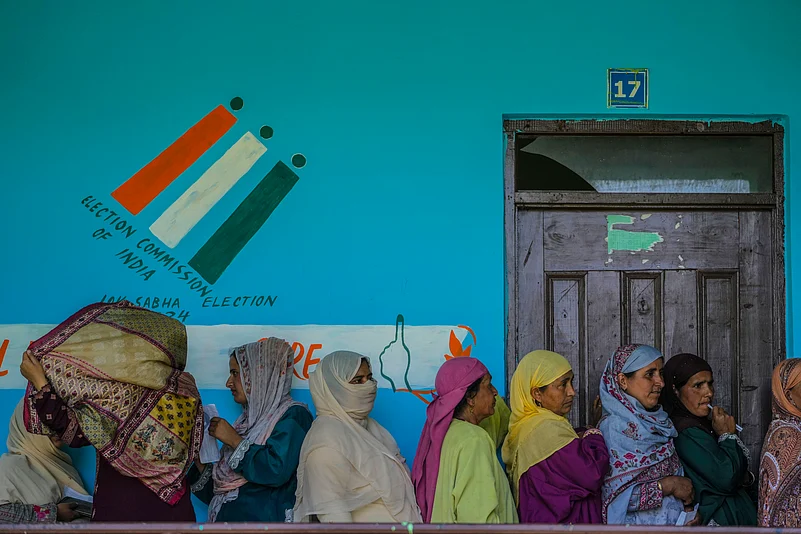Even though the business end of India’s mammoth seven-week long election comes closer, the Election Commission of India has been facing public ire over not releasing the exact voter turnout numbers and instead supplying only the percentage of voter turnout.
Election Commission's Delay Over Voter Turnout Figures Raises Concerns: What's Wrong With It?
The poll body has only been releasing the voter turnout percentage in stark contrast to 2019 general elections, when it published data with actual total voters and gender-wise breakup with absolute numbers

The fifth phase of the Lok Sabha election concluded on Monday, which registered a voter turnout of 60.09 per cent till 11.30 pm. The poll panel said the final turnout will only be available after the results, with the counting of postal ballots and its addition to the total voting percentage.
However, this is in stark contrast to how the poll panel released voter turnout data during the 2019 general elections: data with actual total voters and gender-wise breakup with absolute numbers was released after polling.
What data has the Election Commission been releasing?
The poll body has only been releasing the voter turnout percentage, that too after much delay: after 11 days of polling for the first phase; after four days of polling for the subsequent phases. Former Chief Election Commissioner S.Y. Qureshi in an interview to Dainik Bhaskar, said that there should be no reasons for delay in the voter turnout data as it is available in real time. “Within five minutes of the polling ending, all information is available. Now, in this situation, the Election Commission is accountable for why so much time is being taken to finalise the data,” he said.
When criticised by opposition leader and Congress president Mallikarjun Kharge, the EC, in a scathing letter to the former, claimed that the Commission is not legally bound to publish any voter turnout data at aggregate level of a constituency, a state or in a phase of election because voter turnout is recorded at polling station level in statutory Form 17 C which is prepared by the presiding officer and signed by the polling agents of candidates present.
“Copies of Form 17 C are shared with polling agents present immediately, as the strongest measure of transparency. So, candidates are aware and in possession of exact voter turnout data in absolute numbers even before it is known to the ECI,” it further said in the letter.
Why are activists concerned?
Civil society activists and organisations have expressed concerns over the correctness of data being released by the EC. The Association for Democratic Reforms (ADR), in its petition to the Supreme Court, noted how there was a discrepancy of more than 5 per cent in the final voter turnout figures as compared to the initial data released on the polling day.
For the first phase of polling, which concluded on April 19, the final voter turnout data was only published 11 days later. The data as published by the ECI in its press release dated April 30 showed a sharp increase by about 5 - 6 per cent as compared to the initial percentages announced by ECI as of 7 pm on the day of polling (From over 60 per cent to 66.14 per cent).
Similarly, for the second phase, EC’s press note on the day of polling (April 26) recorded the voter turnout as 60.96 per cent as of 7 pm, while the revised figure in the press note on April 30 pegged the turnout at 66.71 per cent.
The delay in the release of final voter turnout data, coupled with the unusually high revised figures and the absence of absolute numbers at the constituency and polling station level, has aroused public suspicion regarding the correctness of the data, the organisation said, adding that these apprehensions must be addressed “in order to uphold the voter’s confidence”.
Further, without absolute numbers of voter turnout, ADR noted that the general public cannot compare the number of votes polled with the number of votes counted as announced in the results, and thus, can only point out discrepancies (if any) between the two data sets when absolute numbers for each constituency are released by the EC.
The group approached the Supreme Court seeking that the Form 17 C be uploaded on the ECI website as soon as it is stamped and signed by the Presiding officer. Further, for the remaining phases, this information must be publicly displayed on the ECI website within 48 hours of the close of polls.
The top court on May 17 asked the EC why it was not supplying the total numbers of votes, as it has always done. A bench headed by Chief Justice of India DY Chandrachud has given seven days for the poll body to file its response and posted the matter for hearing on May 24, which is a day before the sixth, or second last phase of polling.
Was this data released during previous general elections?
In 2019, the Election Commission had released absolute numbers of gender-wise turnout in each constituency for the first phase on April 13, two days after polling on April 11.
Poonam Agarwal, an independent journalist and advocate who found discrepancies in the number of votes counted and number of votes polled in the 2019 Lok Sabha elections, noted in an article for The Wire that the voter turnout data of the 2019 Lok Sabha elections not just carried the votes polled data in numbers and percentage, but also had a comparison with the voter turnout data of the 2014 Lok Sabha elections.
-
Previous Story
 ‘Staying Out Of Power Has Made Congress Desperate’: PM Modi Slams Rahul Over ‘Country On Fire’ Remark
‘Staying Out Of Power Has Made Congress Desperate’: PM Modi Slams Rahul Over ‘Country On Fire’ Remark - Next Story





















